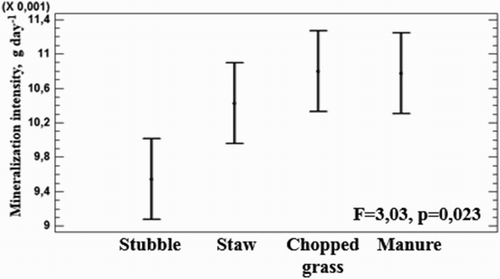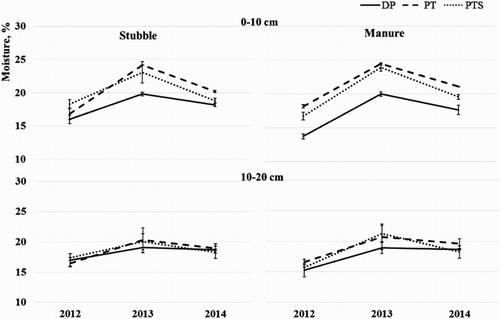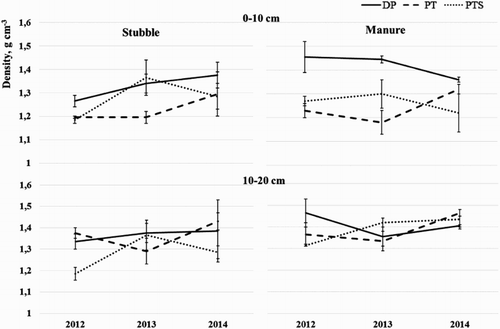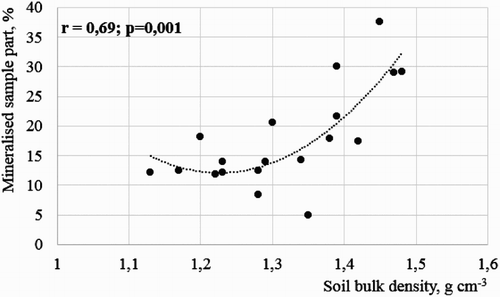ABSTRACT
Mineralization is the main organic matter conversion process, which leads not only to preservation of organic matter in the soil but also to its sequestration. Soil organic matter has equal value as mineral part if we want to improve soil quality or increase the yield. Because of intensive farming, irresponsible use of mineral fertilizers and natural factors, soil organic matter is decreasing. To counteract this process, different soil-friendly management practices and techniques, such as shallow tillage, no-tillage or direct drilling and application of additional organic matter are used. The objective of the present study was to assess the changes in the intensity of soil organic matter mineralization as influenced by primary soil tillage of different intensity in combination with organic matter incorporation. Long-term studies showed that land management practices differentiated the soil into two layers: upper (0–10 cm) layer containing more moisture and nutrients and lower (10–20 cm) layer comprising less moisture and nutrients. The conditions of aeration in the arable soil layer did not change under the effect of ploughing. In this soil, the rate of mineralization was lower than that in the ploughless tillage treatment. The most active mineralization of soil organic matter in the ploughless tillage treatment occurred in the autumn period, when high level of rainfall promoted the loss of nutrients from the topsoil layer.
Introduction
Mineralization is the main organic matter conversion process, which leads not only to preservation of organic matter in the soil but also to its sequestration (Schrumpf et al. Citation2013). Through the process of mineralization energy is provided to organisms and nutrients are released for uptake by both microorganisms and plants (Gougoulias et al. Citation2014). The two key factors that govern soil organic matter decomposition rate are: (1) soil microorganism activity; (2) the capacity of clay particles to form complexes between metal ions associated with clay surface (Mouhamad et al. Citation2015). The mineralization process depends on soil structure and texture, climatic conditions, chemical composition of organic matter, and anthropogenic activity – tillage systems and fertilization (Das et al. Citation2014; Mouhamad et al. Citation2015). To reduce the use of mineral fertilizers, they are often replaced by green manure, which not only enriches the soil with nutrients but also affects its physical and biological properties (Skuodienė & Nekrošien- Citation2012; Piotrowska-Dlugosz & Wilczewski Citation2014). Tillage is one of the major factors that affect soil properties. The no-till systems or shallow ploughless tillage are opposite of traditional deep ploughing, no-tillage systems, for instance, increase soil organic matter by reducing mineralization rates and stimulating litter concentrations of the top soil layer, whereas deep ploughing increases the biological activity of arable soil layer and reduces the incidence of weeds (Sapkota et al. Citation2012; Juarez et al. Citation2013; Karlen et al. Citation2013; Zhang et al. Citation2013). Numerous studies and experiments have been done to assess the impact of organic matter content and quality on soil properties, with a focus on physical and chemical properties. However, there is still not enough knowledge about the interaction between soil physical properties, such as bulk density or moisture and organic matter mineralization rate. We hypothesized that: (1) the mineralization rate is higher in shallow ploughless tillage and (2) the SOM mineralization rate depends on the type of green manure; (3) the different tillage practices affect the soil physical properties.
Materials and methods
Study area
The study site is a long-term field experimental established at Lithuanian Research Centre for Agriculture and Forestry, Vezaiciai Branch in 2003. This site is located in a humid continental climate region (Dfb in the Koeppen climate classification) in the western part of Lithuania. The soil of the experimental site is Bathygleyic Dystric Glossic Retisol (WRB Citation2014) with a moraine loam texture. The soil properties under study and determination methods are presented in . Before we started our study, the experimental field had been used for soil tillage trials in a four-field crop rotation.
Table 1. Chemical characteristics (arithmetic mean ± standard deviation) of the soil at the beginning of the experiment 2013.
The experiment was set up in 2013 and had a split-plot design where the whole-plot treatments were laid out in a randomized design with three replicates. The whole-plot treatments consisted of three tillage methods – deep ploughing (22–25 cm) (DP), ploughless tillage (7–10 cm) (PT) and ploughless tillage (7–10 cm) with additional deep loosening (up to 40 cm), which was applied every 4 years (PTS). The split-plot treatments involved four types of additional organic fertilizers: stubble (S), chopped straw + N10 (ChS), chopped grass (1st cut) + N10 (G) and farmyard manure 40 t ha−1(M). Soil samples were taken from the two layers of the soil profile, the upper 0–10 cm, and the lower 10–20 cm. The experiment had a total of 36 plots (10 m × 5 m) with 12 different treatment combinations.
Assessment of mineralization process intensity
The experiment was conducted during the period from October 2013 to July 2015. To estimate organic matter mineralization intensity, we used specially designed plastic bags with a pore diameter of 0.05 mm, filled them with 5 g of chopped straw 3–5 cm in length and buried them in the soil in both layers 0–10 and 10–20 cm. The bags were periodically removed from the soil and tested for mineralization rate. The rate of mineralization per day was calculated by dividing the straw weight, after removing from the soil, by the number of days it had been buried. The first samples were removed from the soil when the average daily air temperature below 5°C persisted for 5 days. The second sampling was done when average daily air temperature above 5°C lasted for 5 days. The last samples were taken in the middle of the summer (in the first 10-day period of July).
Meteorological conditions
The amount of precipitation differed between the experimental years. In the autumn of 2013, the amount of precipitation was 30.37% of total annual precipitation rate, whereas in the same period of 2014 it amounted to 3.9%. The autumn of 2014 was not typical of West Lithuania’s climate because there was a severe drought. The major part of precipitation occurred in the winter season, it varied from 52.84% to 79.54%, and in the summer time it was around 16% of the total annual precipitation rate.
The average daily temperature was similar in both experimental years. In the autumn, it varied from 4.45°C to 6.37°C, in the winter from 1.72°C to 2.3°C, in the summer from 12.42°C to 12.84°C ().
Statistical analysis
The data of organic matter mineralization were analyzed as a split-plot design. To assess the relationships between the two indicators we used Pearson’s correlation coefficient. Statistical computations were performed using the statistical software package ANOVA.
Results and discussion
Mineralization rate under different land management systems
The significantly highest mineralization rate was in the autumn F = 276.03; p = .001. Based on these results and according to the monitoring data, which show that the highest precipitation amount and relatively high air temperature (>5°C) during the autumn period might determine the possible nutrient losses from top soil layers, which may in turn result in lower soil fertility, smaller crop yield, and potential hydro ecosystems pollution (Long & Sun Citation2012). For this reason, further results of the mineralization activity and soil physical properties fluctuation, presented in this study refer to the autumn period ().
Figure 2. Mineralization intensity per day during different seasons: I – autumn, II – winter–spring; III – spring–summer.
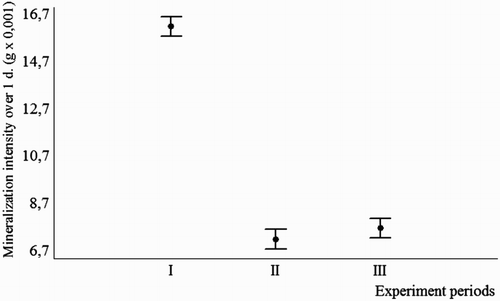
The significantly highest mineralization rate () was determined in the shallow ploughless tillage (F = 4.94, p = .008), which confirmed our hypothesis. There was no significant difference in the mineralization rate between the traditional deep ploughing and shallow ploughless tillage with deep loosening. Soil layer had no statistically significant effect (F = 1.33; p = .25) on the mineralization intensity, but there was observed a tendency that conventional tillage activated the microbiota in the topsoil layer (0–10 cm), meanwhile in the ploughless tillage mineralization process was more active in the deeper layer (10–20 cm). A. Sengupta & Dick (Citation2015) have concluded that ploughing tends to homogenize the soil and reduce the unique microenvironments where microbial populations can reside, for this reason, in the ploughless tillage 10–20 cm layer is undisturbed, and microorganisms are more active than in the top layer.
Figure 3. Mineralized sample part (%) under different land management practices during the autumn season.
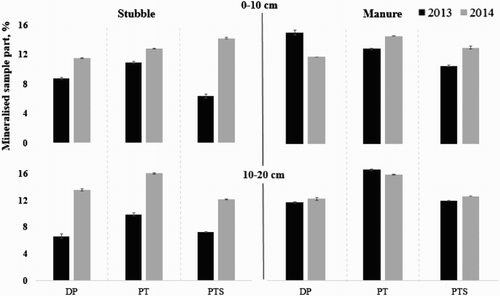
Not all additional organic fertilizers had a significant effect on the organic matter mineralization intensity. Chopped grass and farmyard manure significantly increased mineralization, while stubble and chopped straw had no statistically significant effect (). However, the mineralization intensity in the soil with additional stubble and straw was significantly lower.
Soil physical properties under different tillage systems
The different tillage systems had a statistically significant effect on the soil bulk density and moisture, whereas total porosity and air-filled porosity did not depend on the tillage system. Soil moisture () was statistically higher in shallow ploughless tillage and shallow ploughless tillage with deep loosening compared with traditional deep ploughing F = 5.54, p = .005. The soil bulk density () was significantly higher in deep ploughing compared with shallow ploughless tillage F = 4.36, p = .01. Soil physical properties significantly differed between the soil layers. Bulk density was higher in the 10–20 cm layer (F = 12.23; p = .001), meanwhile total porosity was higher in the 0–10 cm layer (F = 11.01; p = .001) in all tillage treatments.
The effect of soil bulk density and moisture on the mineralization
In the deep ploughing treatment, the part of mineralized matter in the samples did not correlate with soil physical properties. In the shallow ploughless tillage ((a)-part) treatment, there was positive moderately strong correlation between part of mineralized matter in the samples and soil bulk density (r = 0.68, p = .001). In the plough less tillage with deep loosening, there was negative moderately strong correlation between the part of mineralized matter in the samples and soil moisture (r = −0.65, p = .001), as well as, positive moderately strong correlation with air-filled porosity (r = 0.63, p = .001) ().
Conclusions
In a Bathygleyic Dystric Glossic Retisol, the rate of organic matter mineralization was lower in the deep ploughing treatments compared with that in the ploughless tillage treatments.
In the ploughless tillage treatments, the mineralization of soil organic matter was very active during the autumn period. The organic matter mineralization rate was the highest in the treatments with addition of manure and chopped grass compared with straw or stubble.
Long-term studies showed that land management practices differentiated the soil into two layers: upper (0–10 cm) layer containing more moisture and nutrients and lower (10–20 cm) layer comprising less moisture and nutrients. Mineralization intensity correlated with soil bulk density (r = 0.69, p = .001) in the shallow ploughless tillage. In the shallow ploughless tillage with deep loosening, organic matter mineralization intensity correlated with soil moisture (r = −0.65; p = .002) and soil air-filled porosity (r = 0.69; p = .003).
Disclosure statement
No potential conflict of interest was reported by the authors.
References
- Das A, Lal R, Patel DP, Idapuganti RG, Layek J, Ngachan SV, Ghosh PK, Bordoloi J, Kumar M. 2014. Effect of tillage and biomass on soil quality and productivity of lowland rice cultivation by small scale farmers in North Eastern India. Soil Till Res. 143:50–58. doi: 10.1016/j.still.2014.05.012
- Gougoulias CH, Clark JM, Shaw L. 2014. The role of soil microbes in the global carbon cycle: tracking the below-ground microbial processing of plant-derived carbon for manipulating carbon dynamics in agricultural systems. J Sci Food Agr. 94(12):2362–2371. doi: 10.1002/jsfa.6577
- Jokubauskaite J, Amaleviciute K, Lepanec V, Slepetiene A, Slepetys J, Liaudanskiene I, Karcauskiene D, Booth CA. 2015. High-performance liquid chromatography (HPLC)-size exclusion chromatography (SEC) for qualitative detection of humic substances and dissolved organic matter in mineral soils and peats in Lithuania. Int J Environ Anal Chem. 95(6):508–519. doi:10.1080/03067319.2015.1048435
- Juarez S, Nunan N, Duday A-C, Pouteau V, Schmidt S, Hapca S, Falconer R, Otten W, Chenu C. 2013. Effects of different soil structures on the decomposition of native and added organic carbon. Eur J Soil Biol. 58:81–90. doi: 10.1016/j.ejsobi.2013.06.005
- Karlen DL, Kovar JL, Cambardella CA, Colvin TS. 2013. Thirty-year tillage effects on crop yield and soil fertility indicators. Soil Till Res. 130:24–41. doi: 10.1016/j.still.2013.02.003
- Long G, Sun B. 2012. Nitrogen leaching under corn cultivation stabilized after four years application of pig manure to red soil in subtropical China. Agr Ecosyst Environ. 146:73–80. doi: 10.1016/j.agee.2011.10.013
- Mouhamad R, Atiyah A, Mohammad R, Iqbal M. 2015. Decomposition of organic matter under different soil textures. Curr Sci Perspect. 1(1):22–25.
- Nikitin BA. 1999. Methods for soil humus determination. Agr Chem. 3(2):156–158.
- Piotrowska-Dlugosz A, Wilczewski E. 2014. Changes in enzyme activities as affected by green-manure catch crops and mineral nitrogen fertilization. Zemdirbyste-Agr. 101(2):139–146. doi: 10.13080/z-a.2014.101.018
- Sapkota TB, Mazzoncini M, Bàrberi P, Antichi D, Silvestri N. 2012. Fifteen years of no till increase soil organic matter, microbial biomass and arthropod diversity in cover crop-based arable cropping systems. Agron Sustain Dev. 32:853–863. doi: 10.1007/s13593-011-0079-0
- Schrumpf M, Kaiser K, Guggenberger G, Persson T, Kogel-Knabner I, Schulze ED. 2013. Storage and stability of organic carbon in soils as related to depth, occlusion within aggregates, and attachment to minerals. Biogeosciences. 10:1675–1691. doi: 10.5194/bg-10-1675-2013
- Sengupta A, Dick WA. 2015. Bacterial community diversity in soil under two tillage practices as determined by pyrosequencing. Microb Ecol. 70(3):853–859. doi: 10.1007/s00248-015-0609-4
- Skuodiene R, Nekrošienė R. 2012. The effect of perennials as green manure on cereal productivity and disease incidence. Span J Agr Res. 10(1):44–54. doi: 10.5424/sjar/2012101-025-11
- WRB. 2014. World reference base for soil resources 2014. International soil classification system for naming soils and creating legends for soil maps. World Soil Resources Reports No. 106. FAO, Rome.
- Zhang S, Li Q, Ying L, Zhang X, Liang W. 2013. Contribution of soil biota to C sequestration varied with aggregate fractions under different tillage systems. Soil Biol Biochem. 62:147–156. doi: 10.1016/j.soilbio.2013.03.023


